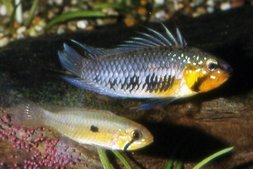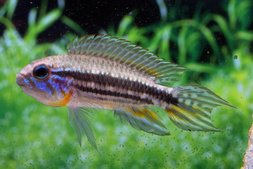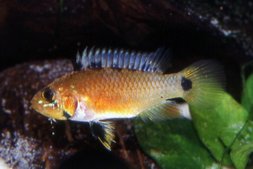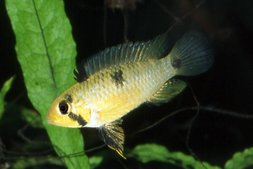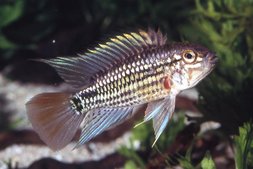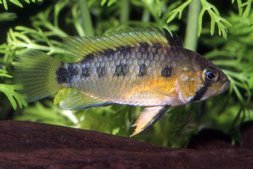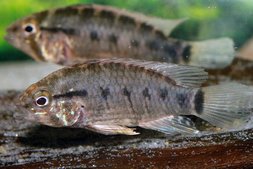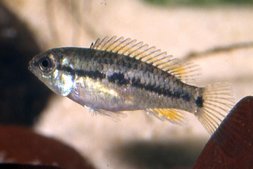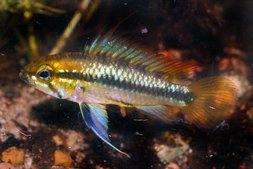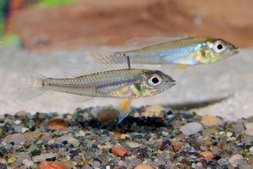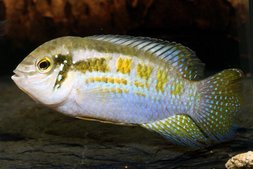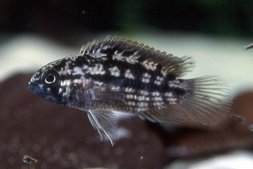South American Dwarf Cichlids
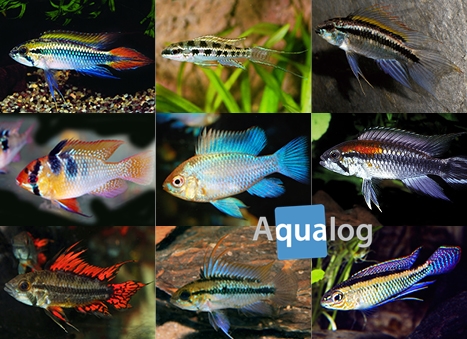
Dwarf cichlids is the term used for all members of the cichlid family (Cichlidae) whose maximum eventual size does not exceed 10 cm.
In South America this means the species of the genera Apistogramma, Apistogrammoides, Nannacara, Ivanacara, Laetacara, Dicrossus, Crenicara, Biotoecus, and Mikrogeophagus. Very few of them have common names and they are known simply “dwarf cichlids”. Exceptions are butterfly dwarf cichlids for Mikrogeophagus and chequerboard cichlids for Dicrossus/Crenicara, while Apistogramma are often called Apistos for short.
The South American dwarf cichlids comprise a total of some 150 species, all of which are readily maintained and bred in the aquarium. In addition there are cultivated forms of some species that exist only in captivity. These cultivated forms differ from the natural or wild forms mainly in their coloration, although there are also long-finned cultivated forms of the Butterfly Dwarf Cichlid (Mikrogeophagus ramirezi).
All South American dwarf cichlids practise brood care, i.e. they guard and look after their eggs and fry and defend them against enemies, but the details of that brood care vary depending on the genus.
Important requirements
In the wild South American dwarf cichlids live mainly in the shallow water of the bank zones of slow-flowing or standing waters. Typical features of the natural habitat include a substrate of fine sand and large quantities of dead leaves from the trees. True aquatic plants are normally absent from the habitat, but grasses and other bank vegetation often extend into the water. As well as the leaf litter, twigs and other pieces of wood serve as hiding-places.
Because dwarf cichlids are found almost everywhere in South America the temperature requirements of the individual species may vary quite considerably. Species from the south (Argentina, Paraguay, Uruguay), from higher altitudes (Bolivia), and from shady jungle streams in Peru should not be kept too warm in the long term, with 20-24° C being a good average, 2-3° C higher for breeding, and periodically 2 °C lower as well. Species from the open areas of Colombia and Venezuela (the llanos) require 26-28 °C and up to 30 °C at breeding time. Amazonian species should be kept at 24-28 °C, with the temperature increased by about 2 °C for breeding.
In the wild many species live in very soft water (0-4° dGH) with an acid pH (pH 4.5 – 5.5), but in the aquarium these values are required only for breeding. Soft to medium-hard water (5-15° dGH) with a slightly acid to neutral pH (pH 6.3 – 7.5) is suitable for the long-term maintenance of most species. Some species will also tolerate hard water (< 20° dGH) and a pH up to around 8.5 without any noticeable effect on their health.
Appropriate feeding
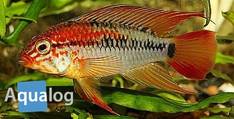
Apistogramma viejita
South American dwarf cichlids are “pickers” and sand-sifters. In otherwise they target individual larger morsels of food or sift the surface of the expanses of sand, picking up a mouthful of sand, “chewing” it, and then spitting it out. Any edible particles of food are retained and swallowed. South American dwarf cichlids are not specialised feeders and can be fed on all the usual sinking foods (flake, granules, frozen and live foods). It is, however, important to ensure that part of the aquarium substrate consists of fine sand (if necessary place a shallow dish of sand in the aquarium). If the fishes are unable to chew sand then they may develop infections of the mouth cavity and the gill area.
Correct maintenance
South American dwarf cichlids are sensitive to a high germ count in the water and to high levels of nitrogenous compounds. For this reason regular large partial water changes are the most important element of maintenance. Ideally 1/3 – 2/3 of the water should be changed every week, refilling with conditioned, fresh water of the same chemistry; at the same time the difference in temperature between the new water and the aquarium water should be as small as possible and never more than 2-3 °C. In aquaria with a low fish density, minimal germ population, and good biological filtration, water changes can be reduced to 1/5 of the total volume every 14 days. Longer intervals should not be employed in the long term.
In line with the natural habitat, these fishes should always have access to secondary plant material. Dead leaves (of Sea Almond, Beech, Oak, or Walnut), Alder cones, or peat can be utilised, or special liquid preparations added at every water change.
Aquarium and tankmates
South American dwarf cichlids are not particularly active swimmers and the aquarium size required is governed mainly by their social behaviour. Apistogramma, Apistogrammoides, Dicrossus, and Crenicara are polygamous, i.e. in the wild a male maintains a harem of several females. The females guard the spawning sites and the brood, the males the territory. Apistogramma and Apistogrammoides spawn in caves, Dicrossus and Crenicara on leaves, wood, etc. In the aquarium these species can be kept in pairs or with an excess of females. A suitable spawning site must be available for each female. In standard-size aquaria only one male of a species should be kept, but in a suitably decorated aquarium it is possible to keep males of different species together as long as their requirements (temperature!) are similar.
Nannacara, Ivanacara, Laetacara, and Mikrogeophagus are open brooders (i.e. they spawn on rocks, wood, etc) with a pair bond; both parents tend and guard the offspring together and share in their defence. Hence these species are kept in pairs. Biotoecus males construct large conical sand-castles and spawn in a pit on the top. Biotoecus are also best kept in pairs or with a surplus of females.
All South American dwarf cichlids are bottom-oriented fishes. Hence if tankmates are desired then these will ideally be fishes that live in the open water column or close to the surface. South American dwarf cichlids are usually tolerant towards other types of fishes and can also look after themselves against larger (but unaggressive!) species.
Life expectancy
Butterfly dwarf cichlids (Mikrogeophagus) are short-lived fishes that usually live no longer than a year. The other species start to show their age after about three years of life. It is probable that none of the species lives longer than a year in the wild.
Size
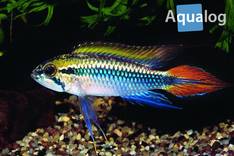
Apistogramma agassizi
Initially South American dwarf cichlids grow quickly and are usually sexually mature after six months at the latest. At this point they will be 1/3 to 1/2 (depending on environmental conditions) of their potential eventual size. Like all fishes, South American dwarf cichlids may continue growing throughout their lives. In all species males grow larger than females. No species grows longer than 10 cm, and the vast majority remain considerably smaller all their lives.
Special details
Because of the large number of species and the lack of recognised common names, it is important to make a note of the scientific name(s) of the species you buy, so that you don’t make mistakes regarding their temperature requirements. Please note the scientific name, the optimal temperature range, the ideal pH value, and the recommended tank size given on the relevant label on the sales aquarium.





